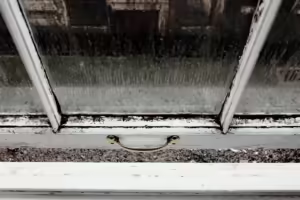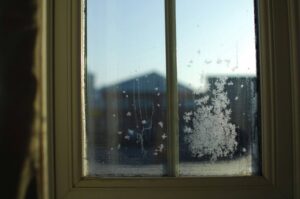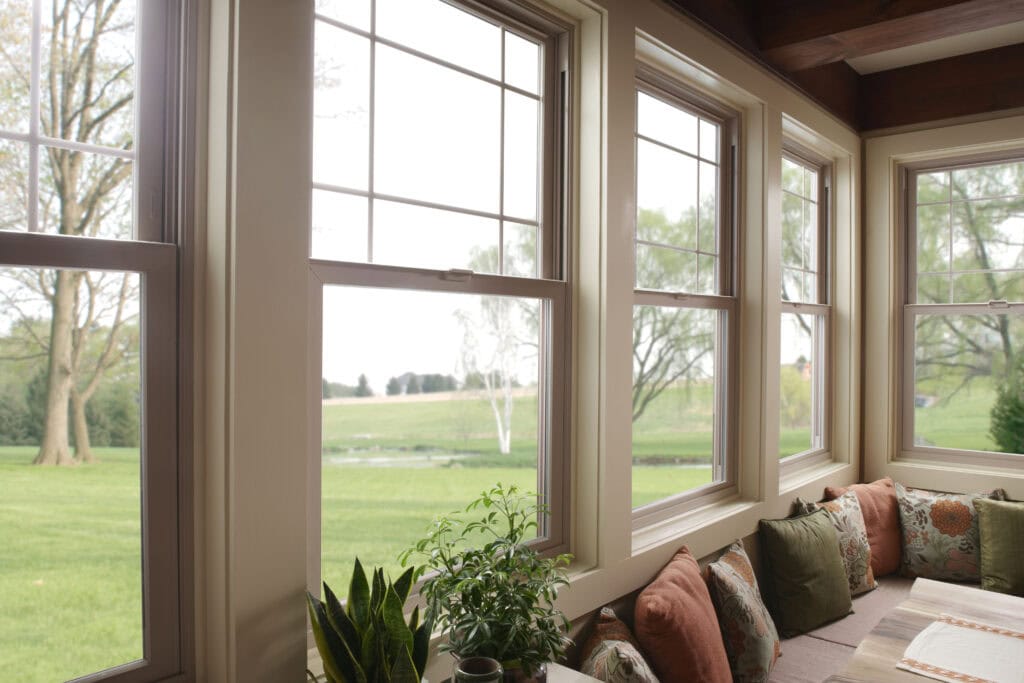
Growth and development of mold and mildew, damage to window frames and sills, high utility bills and energy consumption, health issues, streaks and stains on windows, moisture on windows in winter, and a clammy atmosphere in the rooms. If any of these sound too familiar, we have some sad news for you: it’s caused by window condensation.
This blog article will go through the details of what causes condensation to build on both the inside and the outside of your windows and why it occurs at certain times of the day. Additionally, we will discuss some effective ways to stop condensation on windows.
Now, let us dive in and find all the answers to your questions. Most importantly, we will learn how to overcome these difficulties without compromising your finances or your peace of mind. So, all the questions like “how to stop condensation on windows overnight” and “why are my windows sweating” won’t ever bother you again.
What Causes Condensation on Windows?
First, let’s uncover what condensation is. When you have warm air in contact with cold surfaces in conditions of high humidity, condensation occurs. A window would be such a surface. This is a result of something called the “dew point temperature”, which is the temperature at which air cools enough to allow the moisture in the air to form as dew.
If you’re wondering, “Why is there condensation on my windows?” it’s due to this process of warm, moist air meeting a cold surface. As a result, the water vapor condenses into droplets that fall down the glass and window frames.
What causes condensation on windows:
- Bad insulation: Since the inner and outer temperatures are quite different, poor insulation of the plastic window causes the formation of condensation on the window.
- Poor ventilation: It results in the circulation of air with increased moisture inside the room. The excess humid air, unable to escape, condenses onto the cold window surfaces.
- High indoor humidity: Cooking, showering, and drying clothes in an inadequately ventilated area raises the indoor humidity.
Poor frame quality, loose seals, or lack of insulation: Condensation is a common problem in older houses. It may also occur on balconies if they are glazed but not insulated properly, due to warm air from an adjacent room.
Mad City Windows recommends preventing condensation before it becomes an issue. The aforementioned factors could have serious consequences:
- Damaged window frames and finishes: The repeated streaks of condensation flowing down can lead to mold growth, black spots in the corners of the frames, and deterioration of the wall’s paint or plaster.
- Growth of mold and mildew: This may result in the emergence of respiratory issues, allergies, and other health problems, especially in children and the elderly.
- Indoor air quality deterioration: The condensation on the windows affects air quality indoors. When moisture is mixed with dust and other pollutants, it fuels the growth of bacteria, viruses, and allergens, which can be highly detrimental to the health of everybody.
- Increased energy bills: Water droplets on the window indicate that your house does not keep the heat well. Poorly sealed windows allow cold air to get in causing a drop in temperature and higher moisture levels. This makes the heating system work harder, hence increasing the energy bills.
Condensation on the Inside of Windows
Excess moisture in your home may cause condensation on the inside of windows, especially during winter when the warm air indoors comes into contact with the cold glass.
Condensation could also occur between window panes if the seal is broken or if the material that absorbs moisture inside the windows is full. It typically forms on the inside pane of the glass in your home.
How to Dehumidify the Room?
Minimizing interior window condensation involves reducing indoor humidity. Here are the ways to help you do it:
- Use fans: When showering or cooking, use portable fans, ceiling fans, or exhaust fans to improve air circulation and lower moisture levels in the bathroom or kitchen.
- Move plants and firewood: They release moisture into the air, especially when they are near windows. Think about moving plants to areas with good airflow and keeping firewood outside to bring down humidity.
- Upgrade your windows: New windows may help not only reduce interior window condensation, but also improve your home’s energy efficiency. So, if you have old, drafty windows, consider replacing them with new ones.
- Adjust humidity levels: Lowering the settings on your humidifier or using a dehumidifier can help maintain your home’s humidity within the ideal range of 30% to 60%.
- Open curtains and blinds: This allows heat to escape, thereby minimizing the warm air that accumulates near the window.
Condensation on the Outside of Windows
Exterior condensation frequently occurs among homeowners during the winter months. The tendency of moisture in the air to collect on your windows’ exterior intensifies if the weather gets colder, with increased wind. This will result in wet, sticky glass that, after some time, may develop water droplets or frost.
What Are the Ways to Reduce Condensation?
Luckily, exterior window condensation typically isn’t harmful to your health or home. However, why not explore the ways you can prevent it?
- Use a water repellent: If you don’t like the appearance, you can use a water repellent for windshields. This will help water droplets slide off the window.
- Trim plants: Consider trimming bushes around the window areas. It will aid in airflow and let sunlight reach the window to dry out excess moisture.
- Raise your home’s temperature: If you’re comfortable with a warmer home, reducing air conditioning use in the summer can help balance indoor and outdoor temperatures.
In case you’re ready for some upgrades to your house, getting new windows is always a solution.
Mad City Windows offers a wide range of replacement windows, from vinyl ones to double-hung windows. Ready to say bye to the exterior condensation?
Condensation Between Window Panes: What to Do?
If you have double-glazed windows and observe moisture between the layers of glass, then that likely means that your window seal has been broken. This breach allows air in between the layers; hence, there is a temperature difference that leads to condensation.
The solution is to change the seals or get replacement windows in order to get rid of condensation between window panes.
But for those who are doubtful, well, here’s a lifehack: soak a towel in vinegar and place it between the panes of glass. The acid in the vinegar will absorb moisture from the air, and the towel will prevent warm air from touching cold glass.
Main Causes of Condensation at Different Times of the Day
Condensation on Windows in the Morning: Inside and Outside
Do you wake up wondering why your windows are so misty? During the night, the temperature drops, allowing the windows to cool down. To the equation, add the moisture you release while sleeping. That’s how you get window condensation in the morning.
Note that if you get the wet window landscape only when you wake up, you shouldn’t worry. However, in case you want to get rid of condensation on the outside of windows:
- Use a water repellent.
- Increase the temperature inside.
- Trim any shrubbery around the window.
Want to reduce condensation on the inside? Easy! Use fans or a dehumidifier.
How to Stop Window Condensation Overnight?
Most of the ways to combat excessive humidity levels were covered in the first part of this blog post. Here are a couple of additional hacks for you to mitigate the condensation on windows:
- Dry clothes outside.
- Keep heating on constantly at a low temperature.
- Properly dry any damp areas around the house.
The Main Causes of Condensation at Different Times of the Year
Spring & Summer
Condensation on windows is a year-round problem. It can also occur during warmer periods such as spring and summer. Why? The air inside is cooler due to the higher humidity levels outside. Typically, during these times, exterior condensation occurs. However, be aware that spring and summer are more humid seasons, so check the humidity levels regularly. To make it easier, we recommend getting a hydrometer.
Winter & Fall
During colder seasons, such as late fall and winter, interior window condensation forms. When the temperature outside lowers and the inside surface gets cooler, it appears to have lower relative humidity levels. Keep in mind that the heating should always be on a constant, low setting, which is useful to prevent condensation on windows in winter. What are the other ways to solve it?
- Clean the windows.
- Adjust the humidifier.
- Increase the temperature inside.
- Use ceiling fans.
Summary
Condensation on windows, though simple as it may seem, becomes a problem in many cases. It mostly comes from indoor humidity, poor insulation, or inefficient ventilation. This can bring about many problems involving mold growth, peeling window frames, and surges in energy consumption.
To never worry about how to stop condensation on windows, proactive measures should include the use of fans for effective air circulation, the adjustment of humidity levels by means of a dehumidifier, and upgrading old windows to more efficient options.
Each section offers valuable tips for various conditions that enable one to maintain a comfortable environment, preserve property, and prevent moisture issues. Whether condensation occurs inside, outside, or between the panes of glass, our tips will help in finding beneficial solutions to such problems.












